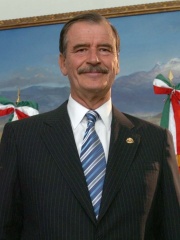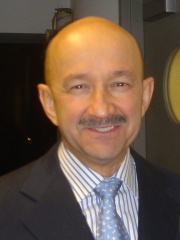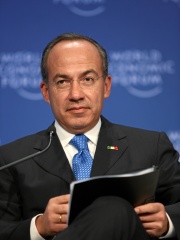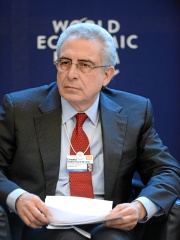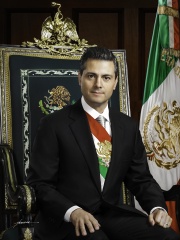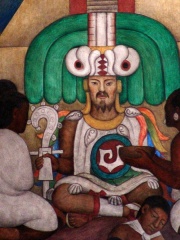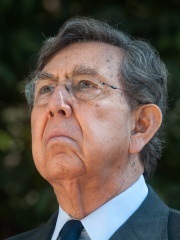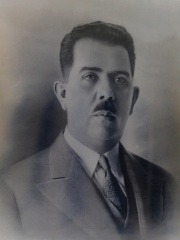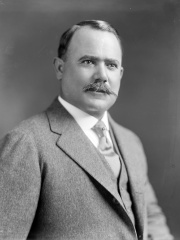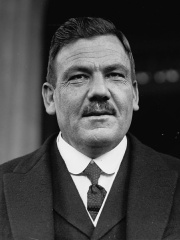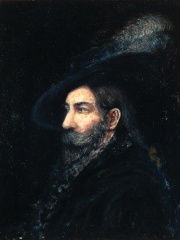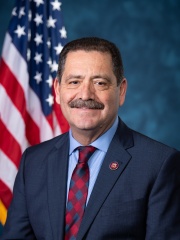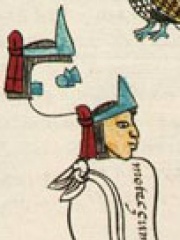
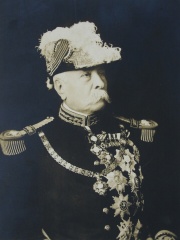
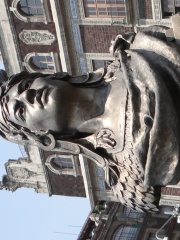
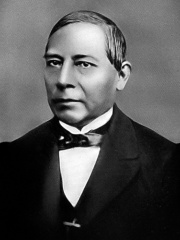
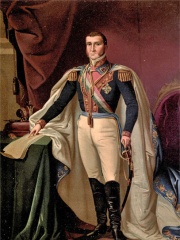
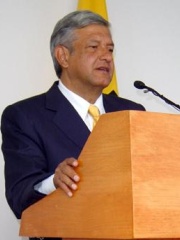
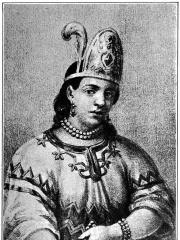
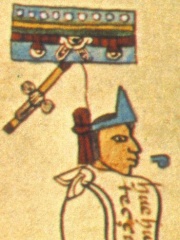
The Most Famous
POLITICIANS from Mexico
This page contains a list of the greatest Mexican Politicians. The pantheon dataset contains 19,576 Politicians, 105 of which were born in Mexico. This makes Mexico the birth place of the 30th most number of Politicians behind Israel, and Bulgaria.
Top 10
The following people are considered by Pantheon to be the top 10 most legendary Mexican Politicians of all time. This list of famous Mexican Politicians is sorted by HPI (Historical Popularity Index), a metric that aggregates information on a biography’s online popularity. Visit the rankings page to view the entire list of Mexican Politicians.

1. Moctezuma II (1466 - 1520)
With an HPI of 71.89, Moctezuma II is the most famous Mexican Politician. His biography has been translated into 62 different languages on wikipedia.
Motecuhzoma Xocoyotzin (c. 1466 – 29 June 1520; [moteːkʷˈs̻oːmaḁ ʃoːkoˈjoːt͡sin̥] ), referred to retroactively in European sources as Moctezuma II, was the ninth Emperor of the Aztec Empire (also known as the Mexica Empire), reigning from 1502 or 1503 to 1520. Through his marriage with Queen Tlapalizquixochtzin of Ecatepec, one of his two wives, he was also king consort of that altepetl.The first contact between the indigenous civilizations of Mesoamerica and Europeans took place during his reign. He was killed during the initial stages of the Spanish conquest of the Aztec Empire when conquistador Hernán Cortés and his men fought to take over the Aztec capital Tenochtitlan. During his reign, the Aztec Empire reached its greatest size. Through warfare, Motecuzoma expanded the territory as far south as Xoconosco in Chiapas and the Isthmus of Tehuantepec, and incorporated the Zapotec and Yopi people into the empire. He changed the previous meritocratic system of social hierarchy and widened the divide between pipiltin (nobles) and macehualtin (commoners) by prohibiting commoners from working in the royal palaces.Though two other Aztec rulers succeeded Motecuhzoma after his death, their reigns were short-lived and the empire quickly collapsed under them. Historical portrayals of Motecuhzoma have mostly been colored by his role as ruler of a defeated nation, and many sources have described him as weak-willed, superstitious, and indecisive. Depictions of his person among his contemporaries, however, are divided; some depict him as one of the greatest leaders Mexico had, a great conqueror who tried his best to maintain his nation together at times of crisis, while others depict him as a tyrant who wanted to take absolute control over the whole empire. Accounts of how he died and who were the perpetrators (Spaniards or natives) differ. His story remains one of the most well-known conquest narratives from the history of European contact with Native Americans, and he has been mentioned or portrayed in numerous works of historical fiction and popular culture.

2. Porfirio Díaz (1830 - 1915)
With an HPI of 67.72, Porfirio Díaz is the 2nd most famous Mexican Politician. His biography has been translated into 62 different languages.
José de la Cruz Porfirio Díaz Mori ( DEE-əss or DEE-az; Spanish: [poɾˈfiɾjo ði.as]; 15 September 1830 – 2 July 1915), known as Porfirio Díaz, was a Mexican general, politician, and later dictator who served seven terms as President of Mexico, a total of 35 years, from 28 November 1876 to 6 December 1876, 17 February 1877 to 1 December 1880, and 1 December 1884 to 25 May 1911. The entire period from 1876 to 1911 is often referred to as the Porfiriato, and has been characterized as a de facto dictatorship.Díaz was born to an Oaxacan family of modest means. He initially studied to become a priest, but eventually switched his studies to law, and among his mentors was the future President of Mexico, Benito Juárez. Díaz increasingly became active in Liberal Party politics fighting with the Liberals to overthrow Santa Anna in the Plan of Ayutla, and also fighting on their side against the Conservative Party in the Reform War. During the Second French Intervention in Mexico, Díaz fought in the Battle of Puebla in 1862, which temporarily repulsed the invaders, but was captured when the French besieged the city with reinforcements a year later. He escaped captivity and made his way to Oaxaca City, becoming political and military commander over all of Southern Mexico, and successfully resisting French efforts to advance upon the region, until Oaxaca City fell before a French siege in 1865. Diaz once more escaped captivity seven months later and rejoined the army of the Mexican Republic as the Second Mexican Empire disintegrated in the wake of the French departure. As Emperor Maximilian made a last stand in Querétaro, Díaz was in command of the forces which took back Mexico City in June 1867. During the era of the Restored Republic, he subsequently revolted against presidents Benito Juárez and Sebastián Lerdo de Tejada on the principle of no re-election. Díaz succeeded in seizing power, ousting Lerdo in a coup in 1876, with the help of his political supporters, and was elected in 1877. In 1880, he stepped down and his political ally Manuel González was elected president, serving from 1880 to 1884. In 1884, Díaz abandoned the idea of no re-election and held office continuously until 1911.A controversial figure in Mexican history, Díaz's regime ended political instability and achieved growth after decades of economic stagnation. He and his allies comprised a group of technocrats known as científicos ("scientists"), whose economic policies benefited a circle of allies and foreign investors, helping hacendados consolidate large estates, often through violent means and legal abuse. These policies grew increasingly unpopular, resulting in civil repression and regional conflicts, as well as strikes and uprisings from labor and the peasantry, groups that did not share in Mexico's growth. Despite public statements in 1908 favoring a return to democracy and not running again for office, Díaz reversed himself and ran in the 1910 election. Díaz, then 80 years old, failed to institutionalize presidential succession, triggering a political crisis between the científicos and the followers of General Bernardo Reyes, allied with the military and peripheral regions of Mexico. After Díaz declared himself the winner for an eighth term, his electoral opponent, wealthy estate owner Francisco I. Madero, issued the Plan of San Luis Potosí calling for armed rebellion against Díaz, leading to the outbreak of the Mexican Revolution. In May 1911, after the Federal Army suffered a number of defeats against the forces supporting Madero, Díaz resigned in the Treaty of Ciudad Juárez and went into exile in Paris, where he died four years later.

3. Cuauhtémoc (1495 - 1525)
With an HPI of 66.77, Cuauhtémoc is the 3rd most famous Mexican Politician. His biography has been translated into 43 different languages.
Cuauhtémoc (Nahuatl pronunciation: [kʷaːʍˈtemoːk] , Spanish pronunciation: [kwawˈtemok] ), also known as Cuauhtemotzín, Guatimozín, or Guatémoc, was the Aztec ruler (tlatoani) of Tenochtitlan from 1520 to 1521, making him the last Aztec Emperor. The name Cuauhtemōc means "one who has descended like an eagle", and is commonly rendered in English as "Descending Eagle", as in the moment when an eagle folds its wings and plummets down to strike its prey. This is a name that implies aggressiveness and determination. Cuauhtémoc took power in 1520 as successor of Cuitláhuac and was a cousin of the late emperor Moctezuma II. His young wife, who was later known as Isabel Moctezuma, was one of Moctezuma's daughters. He ascended to the throne when he was around 25 years old, while Tenochtitlan was being besieged by the Spanish and devastated by an epidemic of smallpox brought to the Americas by Spanish conquerors. After the killings in the Great Temple, there were probably few Aztec captains available to take the position.

4. Benito Juárez (1806 - 1872)
With an HPI of 66.18, Benito Juárez is the 4th most famous Mexican Politician. His biography has been translated into 72 different languages.
Benito Pablo Juárez García (Spanish: [beˈnito ˈpaβlo ˈxwaɾes ɣaɾˈsi.a] ; 21 March 1806 – 18 July 1872) was a Mexican Liberal lawyer and statesman who served as the 26th president of Mexico from 1858 until his death in office in 1872. Of Zapotec ancestry, he was the first and only indigenous president of Mexico and the first democratically elected indigenous president in the postcolonial Americas. Previously, he had served as Governor of Oaxaca and had later ascended to a variety of federal posts including Secretary of the Interior, Secretary of Public Education, and President of the Supreme Court. During his presidency he led the Liberals to victory in the Reform War and in the Second French intervention in Mexico. Born in Oaxaca to a poor, rural, Indigenous family and orphaned as a child, Juárez passed under the care of his uncle, eventually moving to Oaxaca City at the age of 12, where he found work as a domestic servant. Sponsored by his employer who was also a lay Franciscan, Juárez temporarily enrolled in a seminary and studied to become a priest, but he later switched his studies to law at the Institute of Sciences and Arts, where he became active in Liberal politics. He began to practice law and was eventually appointed as a judge, after which he married Margarita Maza, a woman from a socially distinguished family in Oaxaca City.Juárez was eventually elected Governor of Oaxaca and became involved in national politics after the ousting of Antonio López de Santa Anna in the Plan of Ayutla. Juárez was made Minister of Justice under the new Liberal president Juan Alvarez. He was instrumental in passing the Juárez Law as part of the broader program of constitutional reforms known as La Reforma (The Reform). As the later head of the Supreme Court, he succeeded to the presidency upon the resignation of the Liberal president Ignacio Comonfort in the early weeks of the Reform War between the Liberal Party and the Conservative Party, and led the Liberal Party to victory after three years of warfare. Almost immediately after the Reform War had ended, President Juárez was faced with a French invasion, the Second French Intervention aimed at overthrowing the government of the Mexican Republic and replacing it with a French-aligned monarchy, the Second Mexican Empire. The French soon gained the collaboration of the Conservative Party who aimed at returning themselves to power after their defeat in the Reform War, but Juárez continued to lead the government and armed forces of the Mexican Republic, even as he was forced by the advances of the French to flee to the north of the country. The Second Mexican Empire would finally collapse in 1867 after the departure of the last French troops two months previously and President Juárez returned to Mexico City where he continued as president until his death due to a heart attack in 1872, but with growing opposition from fellow Liberals who believed he was becoming autocratic.During his presidency, he supported a number of controversial measures, including his negotiation of the McLane–Ocampo Treaty, which would have granted the United States perpetual extraterritorial rights across the Isthmus of Tehuantepec; a decree extending his presidential term for the duration of French Intervention; his proposal to revise the liberal Constitution of 1857 to strengthen the power of the federal government; and his decision to run for reelection in 1871. His opponent, liberal general, and fellow Oaxacan Porfirio Díaz opposed his re-election and rebelled against Juárez in the Plan de la Noria. Juárez came to be seen as "a preeminent symbol of Mexican nationalism and resistance to foreign intervention". His policies advocated civil liberties, equality before the law, the sovereignty of civilian power over the Catholic Church and the military, the strengthening of the Mexican federal government, and the depersonalization of political life. For Juárez's success in ousting French invasion, Mexicans considered Juárez's tenure as a time of a "second struggle for independence, a second defeat for the European powers, and a second reversal of the Conquest".After his death, the city of Oaxaca added "de Juárez" to its name in his honor, and numerous other places and institutions have been named after him. He is the only individual whose birthday (21 March) is celebrated as a national public and patriotic holiday in Mexico. Many cities (most notably Ciudad Juárez), streets, institutions, and other locations are named after him. He is considered the most popular Mexican president of the 19th century.
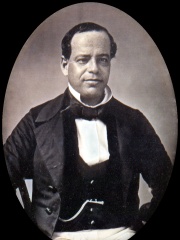
5. Antonio López de Santa Anna (1794 - 1876)
With an HPI of 65.31, Antonio López de Santa Anna is the 5th most famous Mexican Politician. His biography has been translated into 51 different languages.
Antonio de Padua María Severino López de Santa Anna y Pérez de Lebrón, usually known as Antonio López de Santa Anna (Spanish pronunciation: [anˈtonjo ˈlopes ðe sanˈtana]; 21 February 1794 – 21 June 1876), or just Santa Anna, was a Mexican soldier, politician, and caudillo who served as the 8th president of Mexico multiple times between 1833 and 1855. He also served as Vice President of Mexico from 1837 to 1839. He was a controversial and pivotal figure in Mexican politics during the 19th century, to the point that he has been called an "uncrowned monarch", and historians often refer to the three decades after Mexican independence as the "Age of Santa Anna".Santa Anna was in charge of the garrison at Veracruz at the time Mexico won independence in 1821. He would go on to play a notable role in the fall of the First Mexican Empire, the fall of the First Mexican Republic, the promulgation of the Constitution of 1835, the establishment of the Centralist Republic of Mexico, the Texas Revolution, the Pastry War, the promulgation of the Constitution of 1843, and the Mexican–American War. He became well known in the United States due to his role in the Texas Revolution and in the Mexican–American War. Throughout his political career, Santa Anna was known for switching sides in the recurring conflict between the Liberal Party and the Conservative Party. He managed to play a prominent role in both discarding the liberal Constitution of 1824 in 1835 and in restoring it in 1847. He came to power as a liberal twice in 1832 and in 1847 respectively, both times sharing power with the liberal statesman Valentín Gómez Farías, and both times Santa Anna overthrew Gómez Farías after switching sides to the conservatives. Santa Anna was also known for his ostentatious and dictatorial style of rule, making use of the military to dissolve Congress multiple times and referring to himself by the honorific title of His Most Serene Highness. His intermittent periods of rule, which lasted from 1832 to 1853, witnessed the loss of Texas, a series of military failures during the Mexican–American War, and the ensuing Mexican Cession. His leadership in the war and his willingness to fight to the bitter end prolonged that conflict: "more than any other single person it was Santa Anna who denied Polk's dream of a short war." Even after the war was over, Santa Anna continued to cede national territory to the Americans through the Gadsden Purchase in 1853. After he was overthrown and exiled in 1855 through the liberal Plan of Ayutla, Santa Anna began to fade into the background in Mexican politics even as the nation entered the decisive period of the Reform War, the Second French Intervention in Mexico, and the establishment of the Second Mexican Empire. An elderly Santa Anna was allowed to return to the nation by President Sebastián Lerdo de Tejada in 1874, and he died in relative obscurity in 1876. Historians debate the exact number of his presidencies, as he would often share power and make use of puppet rulers; biographer Will Fowler gives the figure of six terms while the Texas State Historical Association claims five. Historian of Latin America, Alexander Dawson counts eleven times that Santa Anna assumed the presidency, often for short periods. The University of Texas Libraries cites the same figure of eleven times, but adds Santa Anna was only president for six years due to short terms.Santa Anna's legacy has subsequently come to be viewed as profoundly negative, with historians and many Mexicans ranking him as "the principal inhabitant even today of Mexico's black pantheon of those who failed the nation". He is considered one of the most unpopular and controversial Mexican presidents of the 19th century.

6. Agustín de Iturbide (1783 - 1824)
With an HPI of 65.07, Agustín de Iturbide is the 6th most famous Mexican Politician. His biography has been translated into 49 different languages.
Agustín de Iturbide (Spanish pronunciation: [aɣusˈtin de ituɾˈbiðe] ; 27 September 1783 – 19 July 1824), full name Agustín Cosme Damián de Iturbide y Arámburu and later known as Emperor Agustín I of Mexico, was an officer in the royal Spanish army. During the Mexican War of Independence he initially fought insurgent forces rebelling against the Spanish crown before changing sides in 1820 and leading a coalition of former royalists and long-time insurgents under his Plan of Iguala. The combined forces under Iturbide brought about Mexican independence in September 1821. After securing the secession of Mexico from Spain, Iturbide was proclaimed president of the Regency in 1821; a year later, he was proclaimed Emperor, reigning from 19 May 1822 to 19 March 1823, when he abdicated. In May 1823 he went into exile in Europe. When he returned to Mexico in July 1824, he was arrested and executed.

7. Andrés Manuel López Obrador (b. 1953)
With an HPI of 65.03, Andrés Manuel López Obrador is the 7th most famous Mexican Politician. His biography has been translated into 70 different languages.
Andrés Manuel López Obrador (Spanish: [anˈdɾes maˈnwel ˈlopes oβɾaˈðoɾ] ; born 13 November 1953), also known by his initials AMLO, is a Mexican politician who is the 65th and current president of Mexico since 2018. He previously served as Head of Government of Mexico City from 2000 to 2005. Born in Tepetitán, in the municipality of Macuspana, in the south-eastern state of Tabasco, López Obrador earned a degree in political science from the National Autonomous University of Mexico following a hiatus from his studies to participate in politics. He began his political career in 1976 as a member of the Institutional Revolutionary Party (PRI). His first public position was as director of the Indigenous Institute of Tabasco, where he promoted the addition of books in indigenous languages and the project of the Chontal ridge. In 1989, he joined the Party of the Democratic Revolution (PRD), becoming the party's 1994 candidate for Governor of Tabasco and national leader between 1996 and 1999. In 2000, he was elected Head of Government of Mexico City. During his tenure, his crime, infrastructure and social spending policies made him a popular figure on the Mexican left. In 2004, his state immunity from prosecution was removed after refusing to cease construction on land allegedly expropriated by his predecessor, Rosario Robles. This legal process lasted a year, ending with López Obrador maintaining his right to run for office.López Obrador was nominated as the presidential candidate for the Coalition for the Good of All during the 2006 elections, where he was narrowly defeated by the National Action Party (PAN) candidate Felipe Calderón. While the Federal Electoral Tribunal noted a number of irregularities, it denied López Obrador's request for a general recount, which sparked protests across the country. In 2011, he founded Morena, a civil association and later political party. He was a candidate for the Progressive Movement coalition in the 2012 elections, won by the Commitment to Mexico coalition candidate Enrique Peña Nieto. In 2012, he left the PRD after protesting the party's signing of the Pact for Mexico and joined Morena. As part of the Juntos Haremos Historia coalition, López Obrador was elected president after a landslide victory in the 2018 general election. Described as being center-left, progressive, left-wing populist, social democratic, and economic nationalist, López Obrador has been a national politician for over three decades. During his presidency, he has promoted public investment in sectors that had been liberalized under previous administrations and has implemented several progressive social reforms. Supporters have praised him for promoting institutional renewal after decades of high inequality and corruption and refocusing the country's neoliberal consensus towards improving the state of the working class. Critics have claimed that he and his administration stumbled in their response to the COVID-19 pandemic and attempts to deal with drug cartels.

8. La Malinche (1502 - 1529)
With an HPI of 64.34, La Malinche is the 8th most famous Mexican Politician. Her biography has been translated into 36 different languages.
Marina [maˈɾina] or Malintzin [maˈlintsin] (c. 1500 – c. 1529), more popularly known as La Malinche [la maˈlintʃe], a Nahua woman from the Mexican Gulf Coast, became known for contributing to the Spanish conquest of the Aztec Empire (1519–1521), by acting as an interpreter, advisor, and intermediary for the Spanish conquistador Hernán Cortés. She was one of 20 enslaved women given to the Spaniards in 1519 by the natives of Tabasco. Cortés chose her as a consort, and she later gave birth to his first son, Martín – one of the first Mestizos (people of mixed European and Indigenous American ancestry) in New Spain.La Malinche's reputation has shifted over the centuries, as various peoples evaluate her role against their own societies' changing social and political perspectives. Especially after the Mexican War of Independence, which led to Mexico's independence from Spain in 1821, dramas, novels, and paintings portrayed her as an evil or scheming temptress. In Mexico today, La Malinche remains a powerful icon - understood in various and often conflicting aspects as the embodiment of treachery, the quintessential victim, or the symbolic mother of the new Mexican people. The term malinchista refers to a disloyal compatriot, especially in Mexico.

9. Moctezuma I (1398 - 1469)
With an HPI of 63.56, Moctezuma I is the 9th most famous Mexican Politician. His biography has been translated into 32 different languages.
Moctezuma I (c. 1398–1469), also known as Moteuczomatzin Ilhuicamina (), Huehuemoteuczoma or Montezuma I (Classical Nahuatl: Motēuczōma Ilhuicamīna [moteːkʷˈsoːma ilwikaˈmiːna], Classical Nahuatl: Huēhuemotēuczōma [weːwemoteːkʷˈsoːma]), was the second Aztec emperor and fifth king of Tenochtitlan. During his reign, the Aztec Empire was consolidated, major expansion was undertaken, and Tenochtitlan started becoming the dominant partner of the Aztec Triple Alliance. Often mistaken for his popular descendant, Moctezuma II, Moctezuma I greatly contributed to the famed Aztec Empire that thrived until Spanish arrival, and he ruled over a period of peace from 1440 to 1453. Moctezuma brought social, economical, and political reform to strengthen Aztec rule, and Tenochtitlan benefited from relations with other cities.
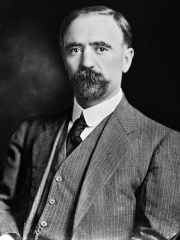
10. Francisco I. Madero (1873 - 1913)
With an HPI of 63.31, Francisco I. Madero is the 10th most famous Mexican Politician. His biography has been translated into 51 different languages.
Francisco I. Madero González (Spanish pronunciation: [fɾanˈsisko jɣˈnasjo maˈðeɾo ɣonˈsales]; 30 October 1873 – 22 February 1913) was a Mexican businessman, revolutionary, writer and statesman, who served as the 37th president of Mexico from 1911 until he was deposed in a coup d'état in February 1913 and assassinated. He came to prominence as an advocate for democracy and as an opponent of President and de facto dictator Porfirio Díaz. After Díaz claimed to have won the fraudulent election of 1910 despite promising a return to democracy, Madero started the Mexican Revolution to oust Díaz. The Mexican revolution would continue until 1920, well after Madero and Díaz's deaths, with hundreds of thousands dead. A member of one of Mexico's wealthiest families, Madero studied business at the École des Hautes Études Commerciales de Paris. An advocate for social justice and democracy, his 1908 book The Presidential Succession in 1910 called Mexican voters to prevent the reelection of Porfirio Díaz, whose regime had become increasingly authoritarian. Bankrolling the opposition Anti-Reelectionist Party, Madero's candidacy garnered widespread support in the country. He challenged Díaz in the 1910 election, which resulted in his arrest. After Díaz declared himself winner for an eighth term in a rigged election, Madero escaped from jail, fled to the United States, and called for the overthrow of his regime in the Plan of San Luis Potosí, sparking the Mexican Revolution. Madero's armed support was concentrated in northern Mexico and was aided by access to arms and finances in the United States. In Chihuahua, Madero recruited wealthy landowner Abraham González to his movement, appointing him provisional governor of the state. González then enlisted Pancho Villa and Pascual Orozco as revolutionary leaders. Madero crossed from Texas into Mexico and took command of a band of revolutionaries, but was defeated in the Battle of Casas Grandes by the Federal Army, which led him to abandon military command roles. Concerned the Battle of Ciudad Juárez would cause casualties in the American city of El Paso and prompt foreign intervention, Madero ordered Villa and Orozco to retreat, but they disobeyed and captured Juárez. Díaz resigned on 25 May 1911 after the signing of the Treaty of Ciudad Juárez and went into exile. Madero retained the Federal Army and dismissed the revolutionary fighters who had forced Díaz's resignation. Madero was enormously popular among many sectors but did not immediately assume the presidency. An interim president was installed, and elections were scheduled. Madero was elected in a landslide and sworn into office on 6 November 1911. The Madero administration soon encountered opposition from conservatives and more radical revolutionaries. Hesitation to implement large-scale land reform efforts upset many of his followers, who viewed it as a promised demand from conflict participation. Workers also became disillusioned by his moderate policies. Former supporter Emiliano Zapata declared himself in rebellion against Madero in the Plan of Ayala, and in the north, Pascual Orozco led an insurrection against him. Foreign investors became concerned that Madero could not maintain political stability, while foreign governments were concerned that a destabilized Mexico would threaten international order. In February 1913, a coup d'état backed by the United States and led by conservative Generals Félix Díaz (a nephew of Porfirio Díaz), Bernardo Reyes, and general Victoriano Huerta was staged in Mexico City, with the latter taking the presidency. Madero was captured and assassinated along with vice-president José María Pino Suárez in a series of events now called the Ten Tragic Days, where his brother Gustavo was tortured and killed. After his assassination, Madero became a unifying force among revolutionary factions against the Huerta regime. In the north, Venustiano Carranza, then Governor of Coahuila, led the nascent Constitutionalist Army; meanwhile, Zapata continued his rebellion against the Federal Government under the Plan of Ayala. Once Huerta was ousted in July 1914, the revolutionary coalitions met in the Convention of Aguascalientes, where disagreements persisted, and Mexico entered a new stage of civil war.
People
Pantheon has 107 people classified as Mexican politicians born between 603 and 1970. Of these 107, 17 (15.89%) of them are still alive today. The most famous living Mexican politicians include Andrés Manuel López Obrador, Vicente Fox, and Carlos Salinas de Gortari. The most famous deceased Mexican politicians include Moctezuma II, Porfirio Díaz, and Cuauhtémoc. As of April 2024, 3 new Mexican politicians have been added to Pantheon including Isabel Moctezuma, Juan Bautista de Anza, and Chuy García.
Living Mexican Politicians
Go to all RankingsAndrés Manuel López Obrador
1953 - Present
HPI: 65.03
Vicente Fox
1942 - Present
HPI: 62.67
Carlos Salinas de Gortari
1948 - Present
HPI: 58.75
Felipe Calderón
1962 - Present
HPI: 56.91
Ernesto Zedillo
1951 - Present
HPI: 56.72
Enrique Peña Nieto
1966 - Present
HPI: 56.62
Ce Acatl Topiltzin
947 - Present
HPI: 55.96
Claudia Sheinbaum
1962 - Present
HPI: 53.24
Cuauhtémoc Cárdenas
1934 - Present
HPI: 52.15
Angélica Rivera
1969 - Present
HPI: 48.07
Marcelo Ebrard
1959 - Present
HPI: 46.72
Patricia Espinosa
1958 - Present
HPI: 43.51
Deceased Mexican Politicians
Go to all RankingsMoctezuma II
1466 - 1520
HPI: 71.89
Porfirio Díaz
1830 - 1915
HPI: 67.72
Cuauhtémoc
1495 - 1525
HPI: 66.77
Benito Juárez
1806 - 1872
HPI: 66.18
Antonio López de Santa Anna
1794 - 1876
HPI: 65.31
Agustín de Iturbide
1783 - 1824
HPI: 65.07
La Malinche
1502 - 1529
HPI: 64.34
Moctezuma I
1398 - 1469
HPI: 63.56
Francisco I. Madero
1873 - 1913
HPI: 63.31
Lázaro Cárdenas
1895 - 1970
HPI: 62.41
Álvaro Obregón
1880 - 1928
HPI: 61.44
Plutarco Elías Calles
1877 - 1945
HPI: 61.21
Newly Added Mexican Politicians (2024)
Go to all RankingsIsabel Moctezuma
1509 - 1550
HPI: 54.50
Juan Bautista de Anza
1736 - 1788
HPI: 46.49
Chuy García
1956 - Present
HPI: 32.66
Overlapping Lives
Which Politicians were alive at the same time? This visualization shows the lifespans of the 25 most globally memorable Politicians since 1700.

